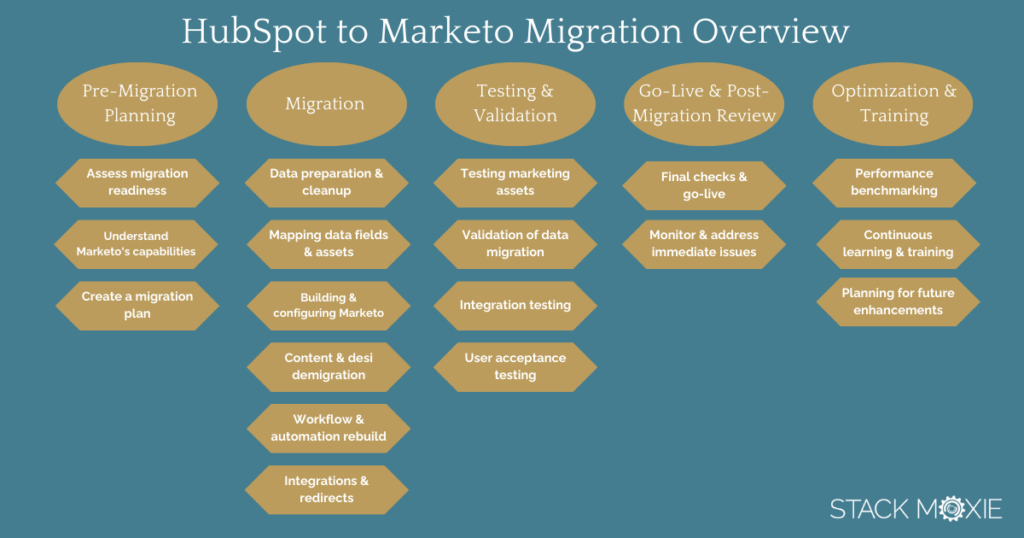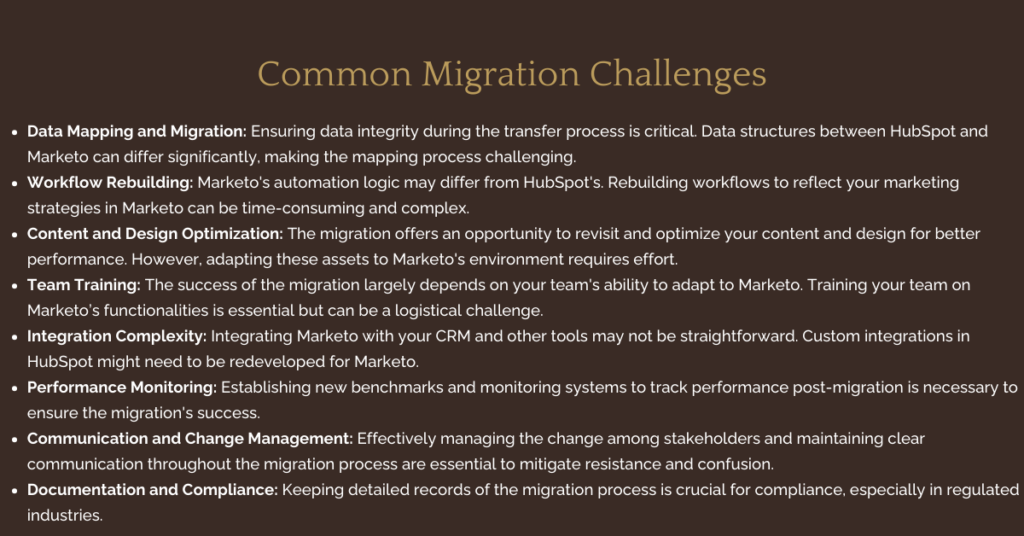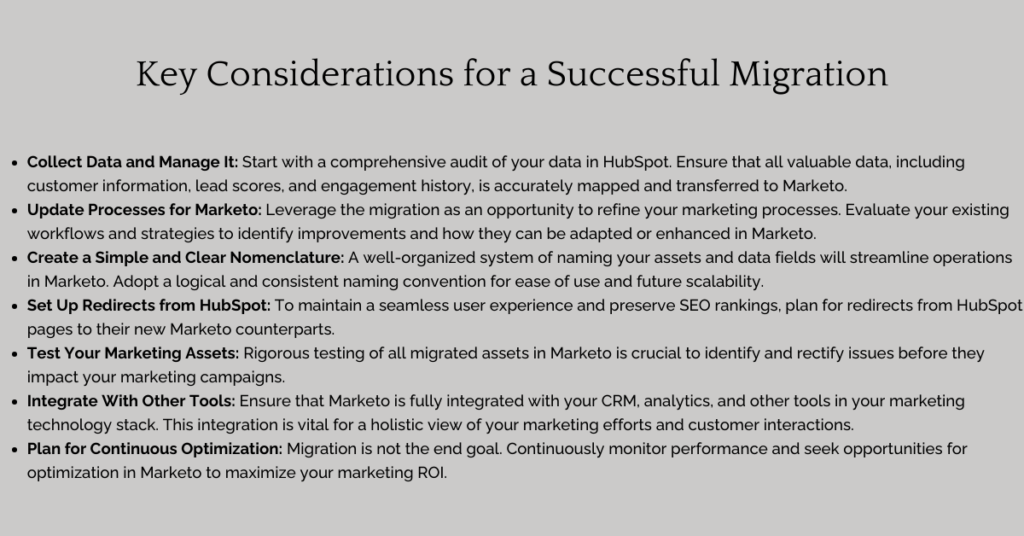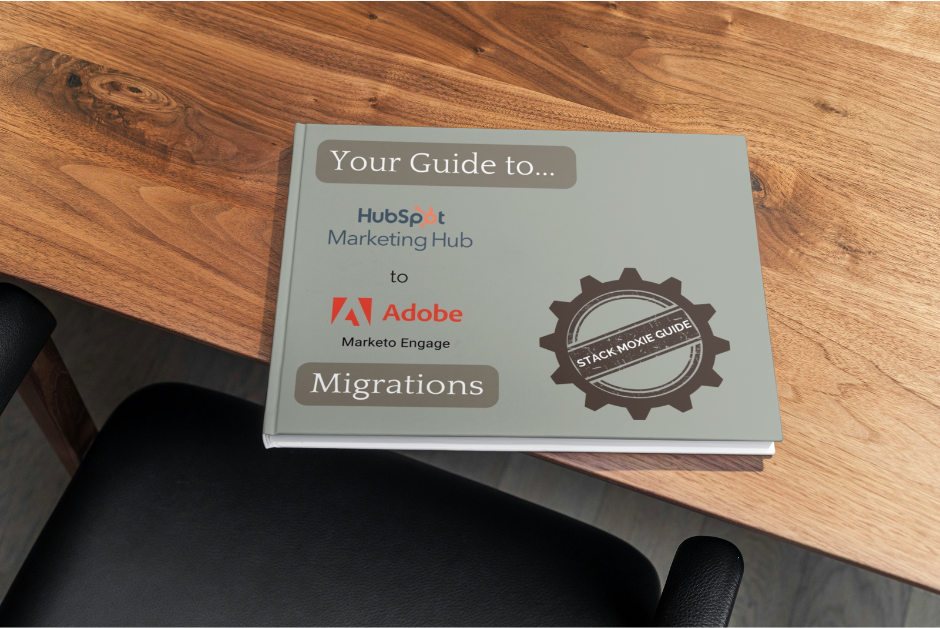If you’re reading this, you’re probably considering moving your team’s marketing automation platform from HubSpot to Adobe Marketo Engage. Embarking on any migration can seem like a daunting endeavor, but it also represents a strategic leap forward for businesses poised for growth and complexity in their marketing operations.
HubSpot and Marketo, two major players in marketing automation, offer distinct landscapes of features and functionalities tailored to diverse marketing needs. HubSpot, with its user-friendly interface and all-in-one marketing suite, caters excellently to inbound marketing strategies and smaller-scale operations. On the other hand, Marketo stands out for its robust lead management, scalability, and advanced customization options, making it the go-to choice for businesses with intricate sales cycles and a focus on extensive lead nurturing.
Performing a HubSpot to Marketo migration can be extremely rewarding, but will test your organization’s ability to manage a complex project involving the transfer of critical data, rethinking workflows, realigning strategies, and adapting to a new system that offers a different set of tools and capabilities. We’ve crafted this guide to help you through the process.

Succeed with Stack Moxie
83% of data migrations either fail outright or exceed their allotted budgets and implementation schedules.
Stack Moxie helps you beat the odds with automated tests that protect your systems and help you achieve a successful migration. Key Stack Moxie tests for migrations include:
- Regression Testing: Ensures that new changes haven’t adversely affected existing functionalities.
- Lead Lifecycle: Monitors the journey of leads to ensure no disruptions or errors.
- GDPR Data Flows: Ensures compliance with data protection standards.
- Lead Mapping: Tracks the alignment and accuracy of lead data.
- MQL Monitoring: Keeps a close eye on Marketing Qualified Leads for any discrepancies.
- Form Regression Testing: Validates the functionality of forms post-migration.
As your team constructs and rolls out migration assets, tests and validations can be built concurrently. This synchronized approach means the moment an asset is deployed, it’s immediately tested. The result? A significant reduction in testing time and the prompt detection of any disruptions.
Additionally, after migrating data, workflows, and integrations, there are fundamental QA tests you should run to ensure the new platform functions as expected. This phase identifies any issues before going live, ensuring a seamless transition for users and maintaining business continuity.
- Functionality Testing: Verify that all features work correctly in the new environment, including data processing, workflow execution, and user interactions.
- Data Verification: Check the accuracy and integrity of migrated data. Ensure all critical data is correctly transferred and accessible.
- Integration Testing: Test the functionality of integrated third-party tools to confirm they work seamlessly with the new platform.
- User Acceptance Testing (UAT): Involve end-users to validate the migration from a user perspective. Gather feedback on usability and address any concerns.
- Performance Testing: Assess the system’s performance under various conditions to ensure it meets operational requirements.
Document any issues encountered during testing, prioritize them based on their impact, and address them promptly. Repeat testing as necessary until all critical issues are resolved, ensuring the platform is reliable and ready for deployment.
Part One: Pre-Migration Planning
Teams with great planning skills and strategic foresight will have the easiest success in their HubSpot to Marketo migration. Phase one sets the stage as a crucial foundation for a smooth transition, ensuring that your move to Marketo not only enhances your marketing capabilities but also aligns with your broader business goals. Here’s how you can prepare effectively:
Assessing Your Migration Readiness
- Evaluate Current HubSpot Usage: Begin by reviewing how your team currently utilizes HubSpot. Identify the features most frequently used and those essential for your marketing operations. This assessment will help you understand the scope of migration and prepare for equivalent or improved functionalities in Marketo.
- Identify Migration Goals and Objectives: Clearly define what you aim to achieve with the migration. Whether it’s accessing more advanced features, improving lead management, or scaling your marketing efforts, understanding your objectives will guide the entire migration process.
Understanding Marketo’s Capabilities
- Key Features and Differences: Familiarize yourself with Marketo’s features, especially those not available or markedly different from HubSpot. This knowledge will help you leverage Marketo’s strengths right from the start.
- Complementary Marketing Strategies: Consider how Marketo’s capabilities can enhance your existing marketing strategies. Marketo’s advanced segmentation, lead scoring, and nurturing tools offer opportunities to refine your approach to lead management and conversion.
Creating a Migration Plan
- Develop a Comprehensive Migration Plan: Outline the steps required for migration, including data cleanup, asset migration, workflow redesign, and integration setups. Assign responsibilities and deadlines to ensure a structured approach.
- Technical and Strategic Preparation: Assess your technical readiness for the migration. This includes reviewing your data structure, understanding Marketo’s API capabilities for integrations, and planning for any custom development work.
- Risk Assessment and Contingency Planning: Identify potential risks associated with the migration, such as data loss or workflow disruption. Develop contingency plans to address these risks, ensuring minimal impact on your marketing operations.
Team Alignment and Training
- Stakeholder Engagement: Engage with key stakeholders across your organization to align on the migration’s goals and timelines. Their buy-in is crucial for a smooth transition.
- Training Needs Assessment: Determine the training needs for your marketing team to ensure they can effectively use Marketo. Plan for training sessions that cover both basic functionalities and advanced features.
Data Cleanup and Preparation
- Audit Your HubSpot Data: Conduct a thorough review of your data in HubSpot. Identify any outdated, incomplete, or redundant data that can be cleaned up before migration.
- Prepare Your Data for Migration: Standardize data formats, clean up lists, and consolidate fields to ensure your data is ready for a seamless transition to Marketo.
This phase of pre-migration planning is about laying the groundwork for a successful transition. By carefully evaluating your current use of HubSpot, understanding Marketo’s capabilities, and creating a detailed migration plan, you set the stage for a migration process that not only transitions your data but also transforms your marketing operations for the better.
Part 2: Migration Challenges and Considerations
Migrating from HubSpot to Marketo is a complex process beyond just the technical transfer of data. This migration will significantly impact your marketing operations and business outcomes. Recognizing and preparing for the challenges you may face during this transition is crucial.
Common Migration Challenges

Key Considerations for a Successful Migration

Part 3: Migration Steps
Step 1: Data Preparation and Cleanup
Begin by exporting relevant data from HubSpot: contacts, leads, marketing assets, reports, and any custom data. Ensure you maintain the data’s integrity and structure during the export.
Review the exported data for inconsistencies, duplicates, and outdated information. Clean up the data to ensure it’s ready for a clean import into Marketo.
Step 2: Mapping Data Fields and Assets
Develop a detailed mapping guide that aligns HubSpot data fields to Marketo fields. This step is crucial for preserving data integrity and ensuring that all information is accurately transferred. Identify any custom fields used in HubSpot and create equivalent fields in Marketo, ensuring that all necessary data has a place in the new system.
Step 3: Building and Configuring Marketo Environment
Now it’s time to configure Marketo lead management. Set up lead scoring, segmentation, and nurturing flows in Marketo. Use insights from your current HubSpot setup to optimize these processes for better engagement and conversion rates.
Create the structural framework for your marketing programs and campaigns in Marketo, aligning with your marketing strategies and goals.
Step 4: Content and Design Migration
Next, transfer your email templates from HubSpot to Marketo. This may require adjustments or redesigns to fit Marketo’s email builder and ensure optimal performance.Migrate your landing pages, forms, and associated assets. Pay attention to design and functionality to ensure they meet your conversion goals in the new environment.

Step 5: Workflow and Automation Rebuilding
Carefully document your automation workflows in HubSpot and recreate them in Marketo. Given the differences in automation capabilities, this step may require creative problem-solving to replicate or improve upon your existing workflows.
Step 6: Integrations and Redirects
Ensure CRM and third-party tool integration by connecting Marketo to your CRM and any other tools you use, such as social media platforms, analytics tools, and content management systems. Test these integrations thoroughly to ensure smooth data flow and functionality.
Set up redirects from your old HubSpot URLs to the new Marketo landing pages and assets to maintain SEO value and user experience.
Step 7: Testing and Validation
Conduct thorough testing of all migrated assets, forms, emails, and automation workflows to ensure they perform as expected. Address any issues before going live.
After importing your data into Marketo, check to ensure all information is correctly mapped and accurately reflects your records from HubSpot.
Step 8: Go-Live and Post-Migration Review
Once testing and validation are complete, and all systems are go, officially make the switch to Marketo for your marketing operations. In the weeks following the migration, monitor the performance closely. Collect feedback from your team on the new platform’s usability and any issues they encounter.
Step 9: Continuous Optimization and Training
Use the data and feedback collected to optimize your marketing strategies in Marketo. Look for opportunities to improve workflows, lead scoring, and engagement strategies.
Ensure your team is fully proficient in using Marketo by providing ongoing training and resources. Encourage exploration of new features and capabilities to maximize the platform’s value.
Part 4: Testing and Validation
Testing and validation are critical phases in the migration from HubSpot to Marketo, ensuring that every component functions as expected in the new environment. This stage mitigates risks, uncovers potential issues, and guarantees that the migrated data and marketing assets perform optimally. Here’s how to approach this essential part of the migration process:
Testing Marketing Assets
- Email Templates and Campaigns: Test all email templates for compatibility and responsiveness across different email clients and devices. Execute test campaigns to verify that segmentation, personalization, and dynamic content function correctly.
- Landing Pages and Forms: Ensure that all landing pages render correctly and are optimized for various screen sizes. Test form submissions to confirm that data collection processes work seamlessly and that leads are routed appropriately within Marketo.
- Automation Workflows: Rigorously test automation workflows to ensure they trigger the intended actions without errors. This includes lead nurturing sequences, scoring rules, and any custom automation you’ve set up.
Validation of Data Migration
- Accuracy Check: Perform a thorough review of the migrated data in Marketo to ensure accuracy. Verify that contact details, lead scores, and custom fields are correctly mapped and appear as expected.
- Integrity and Completeness: Ensure that no data was lost or corrupted during the migration. Check for completeness, especially for critical data that drives segmentation, personalization, and reporting.
- Functional Testing: Validate the functionality of the migrated data within Marketo by conducting tests such as segment creation, list building, and reporting. Confirm that the data supports these functions without issues.
Integration Testing
- CRM and Third-Party Tools: Test the integration between Marketo and your CRM, along with any other third-party tools, to confirm that data syncs accurately in real-time. Pay special attention to lead sync processes, custom field mappings, and event tracking.
- API Connections: For custom integrations developed through APIs, conduct end-to-end testing to ensure stable connections and correct data exchange between Marketo and external systems.
User Acceptance Testing (UAT)
- Stakeholder Review: Involve key stakeholders and end-users in the testing process to gather feedback on the functionality and usability of the Marketo setup. This includes marketing team members, sales representatives, and IT personnel.
- Scenario-Based Testing: Create real-world scenarios that reflect typical marketing and sales processes to validate the overall system performance. Address any issues identified to ensure the platform supports your business workflows effectively.
Performance Monitoring and Benchmarking
- Set Performance Benchmarks: Establish new performance benchmarks for key metrics in Marketo. This may include email open rates, conversion rates on landing pages, and lead generation volumes.
- Monitor Post-Migration Performance: Closely monitor these metrics after the migration to identify any deviations from expected performance levels. Analyze data to pinpoint the cause of any issues and implement corrective actions.
Part 5: Go-Live and Post-Migration Optimization
The final phase of your migration from HubSpot to Marketo involves going live with your new setup and entering a phase of continuous optimization. This stage is crucial for leveraging Marketo’s capabilities to their fullest and ensuring that your marketing operations not only return to their pre-migration performance levels but exceed them.
Finalizing the Migration
Before going live, ensure all data has been accurately migrated, all marketing assets are tested and validated, and all integrations are functioning correctly. Confirm that your team feels confident using Marketo and understands the new processes.
Inform all stakeholders about the go-live date and what to expect during the transition. Clear communication helps manage expectations and minimizes disruptions to your marketing activities.
Go-Live
Activate your marketing operations in Marketo, including all live campaigns, lead nurturing workflows, and real-time data integrations. This marks the official switch from HubSpot to Marketo!
In the initial days post-go-live, monitor the system closely for any unexpected behavior or issues. Keep a rapid response team ready to address any problems that arise.
Post-Migration Review
After going live, review the entire migration process to identify successes, challenges, and areas for improvement. This audit can provide valuable insights for future technology transitions. Collect feedback from your team on the migration experience and their initial impressions of working with Marketo. Use this feedback to address any concerns and improve your marketing operations.
Continuous Optimization and Training
Use the new performance benchmarks established in Marketo to identify areas for optimization. Continuously analyze campaign performance, lead generation activities, and automation workflows for opportunities to improve.
Refine your lead scoring models and segmentation strategies based on real-world data and interactions in Marketo. These iterations can enhance the relevance and effectiveness of your marketing efforts.
Marketo’s capabilities are extensive, and continuous learning is key to unlocking its full potential. Invest in ongoing training for your team, encouraging them to explore advanced features and best practices. Also be sure to engage with Marketo’s user community and take advantage of the resources available through Marketo University. These resources can provide support, inspiration, and practical tips for maximizing your use of the platform.
Planning for Future Enhancements
Marketo regularly introduces new features and updates. Stay informed about these developments and assess how they can be incorporated into your marketing strategy. Set up a schedule for regular reviews of your Marketo setup, including data management practices, marketing automation workflows, and integration health. This proactive approach ensures your marketing technology stack remains aligned with your business objectives.

